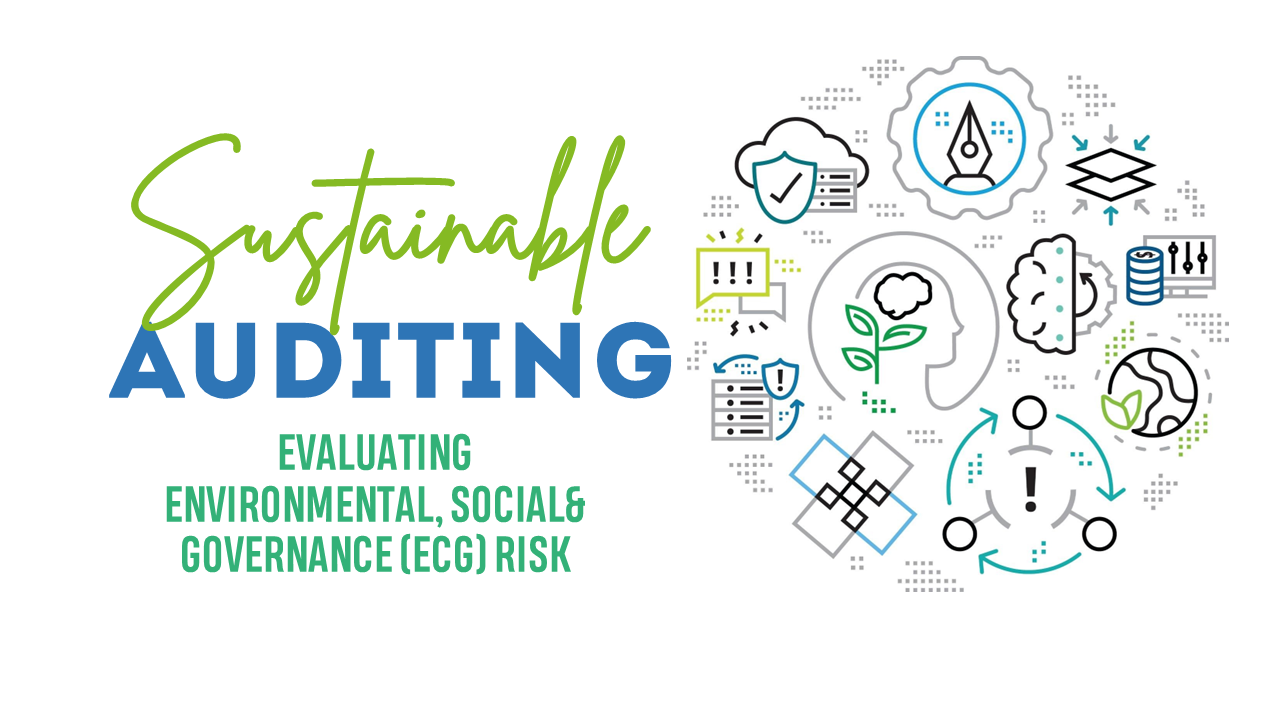SUSTAINABLE AUDITING: EVALUATING ENVIRONMENTAL, SOCIAL AND GOVERNANCE (ECG) RISKS- Part III
Identification of ESG Risks & Materiality Assessment
- IDENTIFICATION OF ESG RISKS
- Gather Relevant Information - Collect data and information related to the organization's operations, industry, and stakeholder concerns. This can include sustainability reports, industry reports, news articles, and stakeholder feedback.
- Engage with Stakeholders - Consult with key stakeholders, such as employees, customers, investors, and local communities, to understand their perspectives and concerns regarding ESG issues.
- Conduct Risk Mapping- Analyze the collected information to identify potential ESG risks associated with the organization's activities, operations, and supply chains. These risks can encompass environmental impacts, social issues, and governance challenges.
- Consider industry specific Risks - Take into account sector-specific risks and trends that may have a significant impact on the organization's sustainability performance. For example, climate change risks for energy companies or supply chain labor issues for manufacturing companies.
- MATERIALITY ASSESSMENT
- Define Materiality - Establish a framework to define materiality based on the significance and impact of ESG risks on the organization and its stakeholders. Materiality refers to the importance or relevance of an ESG issue in relation to the organization's strategy, performance, and stakeholder expectations.
- Determine assessment criteria- Develop criteria to evaluate the materiality of identified ESG risks. These criteria can include financial impact, legal and regulatory requirements, stakeholder expectations, reputation, and strategic importance.
- Assess ESG risks - Evaluate each identified risk against the materiality criteria. Consider the potential impact of the risk on the organization's financial performance, brand reputation, stakeholder trust, and long-term sustainability.
- Prioritize material risks - Prioritize the identified risks based on their level of materiality. Focus on risks that are highly significant, have a higher likelihood of occurrence, or have a greater potential impact on the organization's sustainability performance and stakeholder relationships.
- Review and update - Regularly review and update the materiality assessment to reflect changing sustainability priorities, stakeholder concerns, regulatory developments, and emerging ESG risks.
Data Collection & Analysis
- DEFINE DATA REQUIREMENTS
- Identify the specific ESG indicators and data points relevant to the organization's sustainability objectives, industry, and stakeholder expectations.
- Determine the data collection period and frequency to ensure a comprehensive and up-to-date assessment.
- DATA SOURCES
- Gather data from internal and external sources. Internal sources may include operational records, financial statements, employee records, and sustainability reports. External sources may include industry reports, benchmarking studies, and publicly available data sets.
- Engage with relevant departments and personnel to access and verify data accuracy and reliability.
- DATA COLLECTION METHODS
- Collect quantitative data through methods such as meter readings, surveys, questionnaires, and financial statements. Examples of quantitative data in sustainable auditing include energy consumption, water usage, greenhouse gas emissions, waste generation, employee turnover rates, and financial performance metrics.
- Capture qualitative data through interviews, focus groups, and open-ended survey questions. This helps gain insights into organizational culture, stakeholder engagement, employee satisfaction, community relations, and governance practices.
- DATA VALIDATION & QUALITY ASSURANCE
- Verify the accuracy, completeness, and reliability of the collected data.
- Conduct data validation checks to ensure consistency, detect errors, and address anomalies.
- Implement quality assurance measures to maintain data integrity throughout the auditing process.
- DATA ANALYSIS
- Use appropriate analytical tools and techniques to analyze the collected data.
- Identify trends, patterns, and correlations within the data to uncover areas of strength, weaknesses, and improvement opportunities.
- Compare the organization's performance against relevant benchmarks, industry standards, and best practices.
- INTERPRETATION & INSIGHTS
- Interpret the analyzed data to derive meaningful insights and assess the organization's ESG performance.
- Identify gaps, risks, and areas for improvement based on the data analysis results.
- Consider the context and materiality of the data to understand the implications for the organization's sustainability strategy and stakeholder expectations.
- REPORTING & COMMUNICATION
- Present the findings of the data analysis in a clear, concise, and informative manner.
- Prepare reports and visual representations that effectively communicate the organization's ESG performance, progress, and challenges.
- Share the results with relevant stakeholders, such as senior management, board of directors, employees, investors, and external auditors.
SUSTAINABLE AUDITING BENEFITS
- IMPROVED SUSTAINABLITIY PERFORMANCE
- ENHANCED REPUTATION & STAKEHOLDER TRUST
- RISK IDENTIFICATION & MITIGATION
- COST SAVING & EFFECIENCY
- COMPLIANCE WITH REGULATION STANDARDS
SUSTAINABLE AUDITING CHALLENGES
- LACK OF CONSISTENT STANDARDS
- DATA AVAILABILITY & QUALITY
- COMPLEXITY OF ESG RISK
- LIMITED STAKEHOLDER ENGAGEMENT
- INTEGRATION WITH BUSINESS STRATEGY
CASE STUDIES
UNILEVER : Unilever, a multinational consumer goods company, has a strong commitment to sustainability. The company implemented a robust sustainable auditing program known as the "Sustainable Living Plan." The plan focuses on various areas, including reducing environmental impact, improving health and well-being, enhancing livelihoods, and promoting sustainable sourcing. Unilever conducts regular audits to assess its progress, measure key performance indicators (KPIs), and identify areas for improvement. The audits help Unilever track its sustainability goals, engage with stakeholders, and drive continuous improvement across its operations
NIKE : Nike, a leading sportswear company, has incorporated sustainable auditing into its supply chain management practices. The company conducts regular audits of its suppliers' facilities to assess compliance with labor standards, environmental practices, and health and safety regulations. Nike's sustainable auditing program aims to improve working conditions, promote fair wages, and minimize environmental impact throughout its supply chain. The audits help identify risks, drive corrective actions, and ensure that suppliers adhere to Nike's Code of Conduct, thereby enhancing transparency and social responsibility in the supply chain
NOVO NORDISK : Novo Nordisk, a global pharmaceutical company, has implemented sustainable auditing to enhance its ESG performance. The company focuses on areas such as responsible manufacturing, ethical business practices, and patient safety. Novo Nordisk conducts audits to assess compliance with ESG standards, monitor environmental performance, and promote ethical behavior. The audits help identify risks, ensure regulatory compliance, and drive continuous improvement in sustainability practices. Novo Nordisk's sustainable auditing efforts have strengthened its reputation as a responsible corporate citizen and contributed to its long-term success.
CONCLUSION
The exploration and adoption of Environmental, Social, and Governance (ESG) practices is not only a responsible choice but also a strategic imperative for organizations. By embracing ESG practices, businesses can position themselves as leaders in sustainability, build trust with stakeholders, and drive long-term value creation. ESG practices offer opportunities for innovation, risk mitigation, and cost savings while ensuring compliance with evolving regulations. They enable organizations to make a positive impact on society and the environment, attracting top talent and accessing new markets. It is crucial for organizations to proactively explore and adopt ESG practices, as they contribute to a more sustainable future and pave the way for resilient and successful businesses in an increasingly complex world



